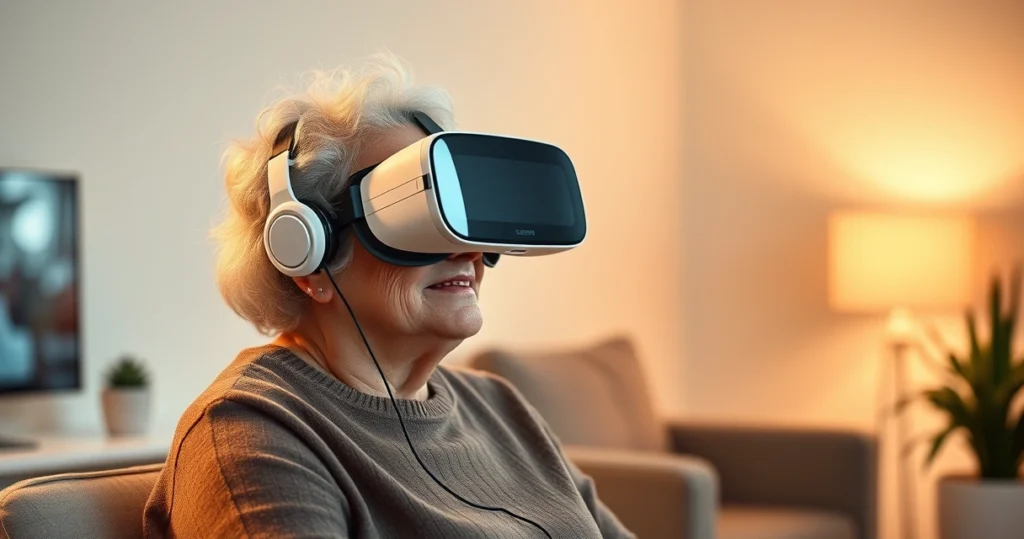Virtual Reality in 2025: How VR Therapy is Giving Seniors a Second Youth
Imagine a world where the warmth of your cherished memories can be relived with vibrant clarity, where the limitations of your physical body cease to exist, and where the mundane routines of daily life become an adventure once more. This isn’t just a fantasy; it’s the burgeoning reality of virtual reality therapy, particularly for seniors, as we approach 2025. You might have witnessed a loved one struggle with the constraints of aging, or perhaps you are contemplating your own future with the apprehension that often accompanies thoughts of growing older. The good news is that VR for seniors is emerging as a transformative force, offering not just escapism, but genuine therapeutic benefits that foster a sense of rejuvenation and vitality.

Think back to a time when your grandparents told you stories of their youth, their eyes sparkling with the memories of places visited and adventures shared. Now, with aging and technology converging in unprecedented ways, virtual reality provides a medium through which those vibrant stories can be retold—not just in words, but in fully immersive experiences. For the elderly, who may feel isolated or physically constrained, VR therapy offers a powerful antidote to loneliness and stagnation, rekindling connections to the world and sparking new conversations that bridge generations.
Consider the implications of virtual reality benefits on elderly mental health. In a society where senior citizens often face the harsh realities of aging alone, VR rehabilitation and therapy present a new dawn. By transporting users to serene landscapes, bustling cityscapes, or even the comfort of their childhood homes, VR for seniors does more than entertain—it nurtures the mind and soul, reinvigorating life itself. As you delve into this article, you’ll discover how VR innovations in 2025 are not just rewriting the narrative of aging but are actively paves ways for seniors to experience a second youth, vibrant and engaging.
The Emergence of VR Therapy for Seniors
Understanding the Basics of VR Therapy
Virtual reality therapy involves the use of VR technology to create immersive environments that can simulate real or imagined experiences. For seniors, this can mean revisiting favorite places, participating in gentle exercise routines, or even engaging in cognitive activities designed to sharpen mental acuity.
- VR headsets tailored for comfort and ease of use
- Customizable experiences to match user preferences and limitations
- Integration with therapeutic programs for physical and mental health
How VR Therapy Enhances Mental Health
One of the critical benefits of VR therapy is its impact on mental health. With aging often comes a decline in mental sharpness, increased feelings of isolation, and depression. VR therapy combats these issues by providing:
- Social interaction: Virtual meet-ups and games that connect seniors with peers
- Memory enhancement: Exercises that engage and stimulate cognitive function
- Mood improvement: Escapes into serene environments that promote relaxation
Tangible Benefits for Physical Rehabilitation
VR therapy isn’t just about mental health; it also offers comprehensive support for physical rehabilitation. Seniors can benefit from:
- Guided physical exercises that promote mobility and strength
- Gamified rehabilitation tasks that make exercise enjoyable
- Reduced pain perception through focus-shifting immersive experiences
Exploring 2025 VR Innovations
Advancements in VR Technology
As technology advances, so too does the capability of virtual reality to offer more nuanced and effective therapeutic experiences. By 2025, expect to see:
- Higher-resolution displays for more realistic environments
- Improved motion tracking for seamless interaction
- Adaptive feedback systems that personalize user experience
Personalized VR Experiences
The future of VR therapy lies in personalization. By tailoring experiences to individual needs and preferences, VR can offer:
- Customizable environments reflecting personal histories
- Adaptive difficulty levels in cognitive exercises
- Personal health metrics integration for optimal results
Integration with Healthcare Systems
Virtual reality is increasingly becoming a staple in healthcare plans, offering seniors seamless access to therapeutic resources:
- VR therapy included in holistic treatment plans
- Remote monitoring by healthcare professionals
- Insurance coverage for VR therapy programs
Practical Applications of VR for Seniors
Case Studies: Success Stories from Around the World
Across the globe, VR therapy is making waves in senior communities. Consider these inspiring instances:
- A retirement community in Japan using VR to simulate travel experiences, reducing feelings of confinement
- A Swedish elderly care facility incorporating VR to help patients with dementia by recreating moments from their past
- An American pilot program that uses VR to assist in post-operative rehabilitation, minimizing recovery time
VR as a Tool for Social Connection
In an era where social distancing can exacerbate loneliness, VR stands as a bridge for connection:
- Virtual family gatherings allowing loved ones to ‘be together’ from anywhere
- Online clubs and societies where seniors can explore shared interests
- Interactive games that foster cooperation and companionship
Cognitive Benefits: Keeping the Mind Agile
VR therapy is a powerful tool in maintaining cognitive health. It helps seniors by:
- Offering memory recall activities that keep the mind sharp
- Providing problem-solving games to enhance critical thinking
- Encouraging lifelong learning with virtual classes and lectures
Aging and Technology: Bridging the Gap
Overcoming Technological Barriers
Technological advancements are only beneficial if they’re accessible. Efforts in 2025 are geared towards:
- Designing user-friendly interfaces specifically for seniors
- Providing comprehensive tech support and education
- Creating affordable options to increase accessibility
Building a Supportive Community
Community plays a crucial role in the uptake of new technologies. Initiatives include:
- Local workshops conducted by tech-savvy volunteers
- Online forums for sharing experiences and troubleshooting
- Collaborations with senior centers to facilitate group sessions
Encouraging Lifelong Learning
Technology like VR can rekindle a love for learning among seniors. This is achieved through:
- Access to virtual libraries and courses
- Opportunities to learn new skills in dynamic ways
- Engagement in cultural and historical explorations without leaving home
Future Prospects of VR Therapy for Seniors
The Long-Term Impact on Senior Health
The long-term benefits of VR therapy could see a significant reduction in age-related diseases and mental decline:
- Potential decreases in depression and anxiety rates
- Improved quality of life and life expectancy
- Greater societal participation by seniors
Emerging Trends in VR Technology
Keeping an eye on the horizon, future trends in VR technology may include:
- Wearable devices with seamless integration
- Augmented reality (AR) hybrids for enhanced experiences
- Greater interactivity with real-world elements
Preparing for a VR-Enriched Future
Both individuals and society must prepare for the integration of VR in daily life. Suggestions include:
- Encouraging open-mindedness towards technology adoption
- Investing in research and development for senior-focused innovations
- Promoting policies that support technological inclusivity for all ages

Frequently Asked Questions
What exactly is virtual reality therapy for seniors?
Virtual reality therapy for seniors involves using VR technology to create immersive experiences that can help improve mental and physical well-being. It includes activities that stimulate the mind, encourage social interaction, and aid in physical rehabilitation, ultimately enhancing the overall quality of life.
How does VR therapy help with elderly mental health?
VR therapy helps elderly mental health by providing immersive experiences that reduce feelings of loneliness and depression. It offers cognitive stimulation and social interaction opportunities, helping keep the mind active and engaged, which is crucial in combating mental decline associated with aging.
Can VR therapy be used for physical rehabilitation?
Yes, VR therapy can be effectively used for physical rehabilitation. It allows seniors to engage in low-impact exercises and rehabilitation tasks within a virtual environment, making physical therapy more enjoyable and accessible. It also offers feedback mechanisms to track progress and adapt exercises to individual needs.
What are the key VR innovations for seniors in 2025?
Key VR innovations for seniors in 2025 include higher-resolution headsets, improved motion tracking, and adaptive feedback systems that personalize experiences. These advancements ensure that VR therapy is more immersive, effective, and tailored to individual needs, enhancing its therapeutic benefits.
How can VR technology help alleviate isolation in seniors?
VR technology can alleviate isolation by facilitating virtual social interactions and community engagement. Seniors can participate in virtual meetups, join clubs, and even take part in family gatherings, maintaining an active social life regardless of physical limitations or geographic barriers.
Are there any cost-effective options for VR therapy for seniors?
Yes, there are cost-effective options for VR therapy for seniors. Many organizations are working to subsidize costs and integrate VR therapy into insurance plans. Additionally, community programs and partnerships with senior centers help make VR therapy more accessible and affordable for the elderly population.
What are some challenges seniors face with adopting VR technology?
Seniors may face challenges such as unfamiliarity with technology, physical limitations that make using headsets difficult, or the initial cost of VR equipment. However, with user-friendly designs, comprehensive support, and educational initiatives, these barriers are gradually being overcome.
What is the future of VR therapy in elderly care?
The future of VR therapy in elderly care looks promising, with continued advancements in technology and increased integration into healthcare systems. It is expected to play a crucial role in enhancing senior care by offering personalized, engaging, and effective therapeutic options that address both mental and physical health needs.
Conclusion: Embracing a Virtual Future
As you navigate the inevitable journey of aging, the advent of virtual reality therapy stands as a beacon of hope. It promises a future where your later years can be filled with as much, if not more, vitality and engagement than your early ones. The convergence of aging and technology is no longer an abstract concept but a tangible reality reshaping how seniors experience the world.
VR therapy not only opens doors to new experiences but also preserves the essence of what makes life enriching—connection, learning, and well-being. Whether you’re an individual seeking vibrant golden years or a family member hoping to enhance a loved one’s quality of life, embracing these virtual reality benefits can transform perceptions of aging from that of decline to one of renewal.
Encourage those around you to explore this exciting realm, and become an advocate for VR for seniors within your community. As VR innovations continue to unfold, your voice and choice can help drive the change needed to make these therapies accessible to all. Engage with the technology today, and pave the path for a future that honors the wisdom of the past with the promise of the future.







